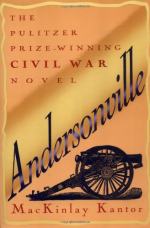We were all exceedingly anxious to know how the Atlanta campaign had ended. So far our information only comprised the facts that a sharp battle had been fought, and the result was the complete possession of our great objective point. The manner of accomplishing this glorious end, the magnitude of the engagement, the regiments, brigades and corps participating, the loss on both sides, the completeness of the victories, etc., were all matters that we knew nothing of, and thirsted to learn.
The Rebel papers said as little as possible about the capture, and the facts in that little were so largely diluted with fiction as to convey no real information. But few new, prisoners were coming in, and none of these were from Sherman. However, toward the last of September, a handful of “fresh fish” were turned inside, whom our experienced eyes instantly told us were Western boys.
There was never any difficulty in telling, as far as he could be seen, whether a boy belonged to the East or the west. First, no one from the Army of the Potomac was ever without his corps badge worn conspicuously; it was rare to see such a thing on one of Sherman’s men. Then there was a dressy air about the Army of the Potomac that was wholly wanting in the soldiers serving west of the Alleghanies.
The Army, of the Potomac was always near to its base of supplies, always had its stores accessible, and the care of the clothing and equipments of the men was an essential part of its discipline. A ragged or shabbily dressed man was a rarity. Dress coats, paper collars, fresh woolen shirts, neat-fitting pantaloons, good comfortable shoes, and trim caps or hats, with all the blazing brass of company letters an inch long, regimental number, bugle and eagle, according to the Regulations, were as common to Eastern boys as they were rare among the Westerners.
The latter usually wore blouses, instead of dress coats, and as a rule their clothing had not been renewed since the opening, of the campaign —and it showed this. Those who wore good boots or shoes generally had to submit to forcible exchanges by their, captors, and the same was true of head gear. The Rebels were badly off in regard to hats. They did not have skill and ingenuity enough to make these out of felt or straw, and the make-shifts they contrived of quilted calico and long-leaved pine, were ugly enough to frighten horned cattle.
I never blamed them much for wanting to get rid of these, even if they did have to commit a sort of highway robbery upon defenseless prisoners to do so. To be a traitor in arms was bad certainly, but one never appreciated the entire magnitude of the crime until he saw a Rebel wearing a calico or a pine-leaf hat. Then one felt as if it would be a great mistake to ever show such a man mercy.
The Army of Northern Virginia seemed to have supplied themselves with head-gear of Yankee manufacture of previous years, and they then quit taking the hats of their prisoners. Johnston’s Army did not have such good luck, and had to keep plundering to the end of the war.




